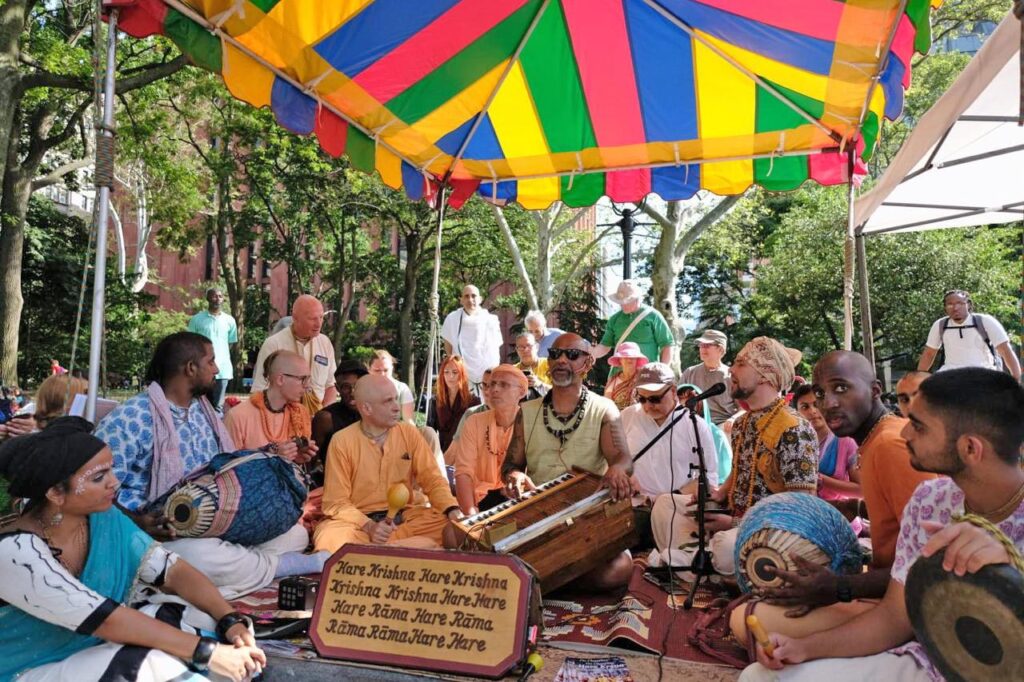At the beginning of the last century the powerful Vaisnava guru Bhaktisiddhanta Saraswati Thakur forcibly reestablished pure devotional Gaudiya practices while driving out its pseudo and insincere counterparts. He thus revealed the authentic personality of Sri Hari Nama Kirtan as, ‘Krishna is His Holy Name, and the Holy Name is Krishna. Krishna Nama is the son of Nanda, Shyamsundar. Sri Nama Sankirtana is the best sadhana. That which is meant for gratifying the mundane senses is not Hari kirtana. That by which Krishna’s senses are satisfied is Hari Kirtana.’
Srila Prabhupada, the foremost disciple of Srila Bhaktisiddhanta, perfectly mirrored his guru’s spirit. He instructed that we should chant feeling the presence of Krishna. If we can’t do that then we should sincerely try to hear ourselves chant and the chanting should be done in a helpless, dependent attitude – like a child crying for its mother. ‘And you can see Krishna face to face in this very lifetime. I guarantee you,’ he says.
Chanting the Hare Krishna maha-mantra on sacred beads a prescribed number of times daily comprises one of our regulative principles and is called japa. Aindra das would say that good japa means good kirtan. Furthermore, he insisted that all the musicians chant during kirtan. ‘Else, whatever you do is zero,’ he’d say.
Madhava came to Vrindavan in early January 1992. He recounts, ‘I checked in the Krishna Balaram guesthouse and still in my travelling clothes, promptly went down to the temple to pay my respects. As I entered, I noticed a few devotees doing kirtan in a corner of the temple room. One of them beckoned me over and asked me to play mridanga. I readily agreed. Shortly after, someone else came and sat down to sing. When he stopped he complimented the mridanga playing and asked me to join the 24-hour kirtan party. I replied that I had a letter for its director. “I am the director,” said Aindra das with a smile. I instantly moved into the ashram where I stayed for the ensuing 5 years, serving Aindra das every day.’
Each Kirtaniya had a 6-hour shift daily. Thus Madhava played 6 hours of mridanga for others besides Aindra das. He recalls that one day, a man dressed in yogi pants joined the kirtan party. He subsequently took the harmonium and sang a simple Hare Krishna tune for 20 minutes. The man thanked Madhava for playing for him, got up and left. Straightaway a senior Hare Krishna devotee came to tell Madhava the man was George Harrison and asked him if he wanted a picture with Celebrity. Madhava declined but was impressed by how unassuming the famous Beatle was.

Aindra das desired to give the Vrindavan experience to the world and he recorded Cintamani Nama, Vrindavan Mellows, Prayers to the Dust and Vraja Vilasa. For Vrindavan Mellows Madhava would go with a tape recorder all over Vrindavan at different times of the day to capture various sounds – peacocks, parrots, rickshaw-wallahs shouting their destinations, an old lady singing the holy name while drawing water from the well and the sound of her bucket clanging while she brings it up, and much more. Aindra das was a perfectionist. He worked on the recordings for almost a year until he deigned to release them. When they came out, they changed kirtan forever worldwide.
Yet Madhava had a grave fault. He rarely sang in kirtan despite Aindra’s reminder that playing musical instruments without chanting is useless venture. He’d call Madhava to his room every day after the evening kirtan, to hammer him with that point; besides telling Madhava he will never be better mridanga player than Lord Shiva, he would often be unrelenting and harsh, bringing Madhava to tears. This lasted a whole year. One day Madhava snapped. He told his mentor to find himself some other mridanga man, left the room and locked himself in his own room. He stayed in for 3 days, neither eating nor drinking nor even using the toilet. Aindra would knock on his door several times a day, saying Radhe Shyam missed his service. He’d bring prasadam to tempt him to open the door. Italian Saunaka Rsi was 16 years old and Madhava’s best friend at the time. He’d also knock on his door, even calling him ill names to get him to open up.
Madhava tells, ‘I did not just sulk those 3 days. Ignoring bodily demands results in clear intelligence. I knew I had to change and finally the next time Aindra das knocked on my door, I opened it ready to submit. He also fed me prasadam. I was starving. Since then I always sing in kirtan.’ After leaving Vrindavan Madhava regularly contacted Aindra das. He has 3 letters from his guide, who each time reiterated the same instructions, to always chant Hare Krsna and never stop practicing his mridanga. The day before Aindra das left the planet, they talked on Skype. Aindra instructed him to travel to new places to spread the kirtan culture. The 5 years under Aindra’s close and affectionate guidance shaped and structured Madhava’s life.
‘I am often asked what technique I use to sing the same melody for indefinite hours. One particular year during my Vrindavan days, I requested Aindra das to allow me the 10pm to 4.30am night shift. He reluctantly agreed, as he wanted that I be alert and focus when playing mridanga for him. That time, two devotees, rarely three, but often one, would do this ‘graveyard’ shift. After the first few nights, time would literally stand still. I quickly realized I had to change my attitude so as to last the one year I’d pledged.
Thus I started to practice listening to the mantra. A few times I’d start a melody, close my eyes and sing it till the 4.30am prayers, marveling at the speed at which that same time had passed.’